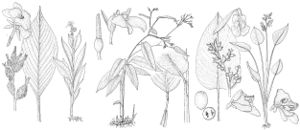Maranta
Sp. Pl. 1: 2. 1753; Gen. Pl., ed. 5; 2, 1754.
| Taxon | Illustrator ⠉ | |
|---|---|---|
 | Maranta arundinacea Canna flaccida Thalia dealbata | John Myers John Myers John Myers |
Plants terrestrial, prostrate, scandent, or upright, usually dying back to rhizome during dry season, 0.1–1.5 (–1.8) m. Rhizomes occasionally swollen, storing starch. Stems branched or unbranched with basal and cauline leaves to highly branched above elongate, canelike stem (internode) with few or no basal leaves. Leaves homotropic [rarely antitropic]; sheath usually auriculate, not spongy; blade [patterned] plain green, ovate to elliptic. Inflorescences usually 2–several per shoot, spikel-like, unbranched; bracts persistent, subtending 2–6 pedicellate flower pairs, herbaceous; prophylls keeled, membranous; secondary bracts absent; bracteoles usually absent. Flowers self-fertilizing [or outcrossing], corolla white, staminodes white [purple]; sepals persistent in fruit, more than 5 mm, herbaceous; corolla-tube [4–] 12–14 mm, corolla lobes unequal; outer staminodes 2, petallike; callose staminode apex usually petallike; cucullate staminode with 1 appendage, medial [subterminal], flaplike [fingerlike]; stylar movement in single plane; style unappendaged. Fruits capsules, 1-seeded, obliquely ellipsoid, pericarp relatively thin, dehiscent. Seeds brown, ellipsoid, rugose; perisperm canal 1, distally branched; aril conspicuous, white.
Distribution
Tropical and subtropical regions, s Mexico, West Indies, Central America, South America (to n Argentina)
Discussion
Species 32 (1 in the flora).